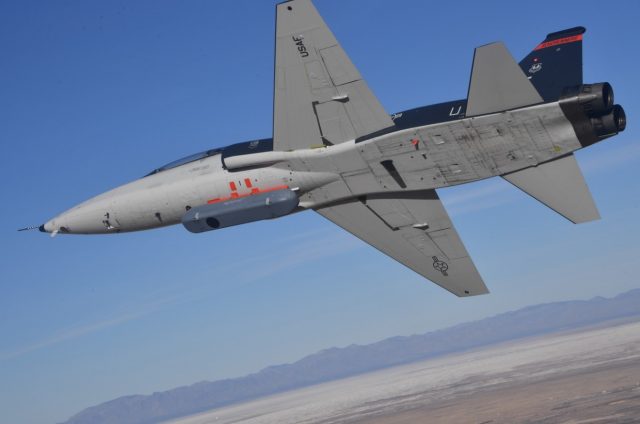
The US Air Force Research Laboratory’s AgilePod prototype, which is designed to help pilots fly in GPS-denied enemy environments, achieved further objectives in flight tests last month.
The test team – representing a broad base of Air Force, Navy, and vendor organizations – successfully executed eight sorties aboard a T-38C aircraft, which included the first test of the complementary position, navigation, and timing (PNT) AgilePod on a high-dynamic-range platform, the first test of fully-remote interfacing and alt-PNT data transmission, and the first demonstration of overland/overwater transition performance.
Maj. Andrew Cottle, of the Air Force Strategic Development Planning and Experimentation (SDPE) office, said PNT AgilePod is a platform that helps develop advanced navigation technology independent of GPS. This technology provides navigation signals through alternative means — increasing mission effectiveness in scenarios where access to GPS is not guaranteed.
He said the tests demonstrated the operational utility of a fused alt-PNT system incorporating multiple technologies within a single government-owned open-architecture prototype.
“The project directly supports the AFRL PNT Enterprise and the Air Force PNT Cross-Functional Team as they work to ensure reliable navigation within GPS-contested operational scenarios critical to the success of future Air and Space Force missions,” Cottle said.
AgilePods are comprised of a series of compartments and can be configured to meet a wide variety of mission requirements for many aircraft platforms. Experimenters can fill the spaces with plug-and-play sensors they need for a mission – high-definition video, electro-optical and infrared sensors, and devices with other capabilities – including PNT.
The AgilePod is based on an open hardware architecture construct. In the case of the complementary PNT prototype, it was combined with an open software architecture that permits a variety of alternative PNT technology to integrate and pass information according to common standards. These capabilities enable integration of sensor technologies through standardized software and hardware interfaces, allowing the pod to integrate on platforms that leverage the standard architectures.
The November flights were the second series of tests for PNT AgilePod. The first were in April, aboard a lower-performance testbed aircraft designed to be a low-risk and low-impact stepping stone to the T-38C.
Cottle said the T-38C was chosen for the follow up test because it was more representative of the high-performance aircraft on which the technologies being developed with on PNT AgilePod will be used.
“Additionally, our AgilePod itself had some updates and changes from the April test that we successfully vetted,” Cottle said. “Finally, whereas the April event occurred exclusively over land, in November we were able to test over water for the first time.”
He said the November tests moved the PNT AgilePod closer to its final transition objectives.
“We learned how the AgilePod could be integrated and operated on a representative high-performance military airframe,” said Cottle. “We encountered and overcame a range of challenges associated with computational, power, and electromagnetic environments that were very different from previous tests.”
“Secondly, we were able to demonstrate the best performance seen to date from our navigation system, and we were able to demonstrate enhanced handling procedures through remote operation and aircrew interfaces.
“Finally, we were able to demonstrate for the first time how our navigation output – composed of two complementary primary input systems – would respond to transitions between land and water terrain.”
Cottle said the PNT AgilePod will continue to mature in its prototype design configuration and will be integrated into a wider range of airframes to demonstrate military utility across a broader range of operational scenarios.
Tom Hill, 586th Flight Test Squadron Technical Director, said the improved AgilePod Open Mission System (OMS) architecture and experiment design allowed breakthrough capabilities. The experiment owners could observe their system behaviors real-time and make updates as necessary “over-the-air.” This substantially improved the efficiency of flight test operations.
Results from the November flights will inform near-term planning for FY22/23 transition objectives aimed at meeting Pacific Air Forces (PACAF) and Air Force Global Strike Command (AFGSC) requirements for robust PNT and Navigation Warfare (NAVWAR), as well as Air Combat Command (ACC) requirements for resilient unmanned aerial system (UAS) navigation.


























